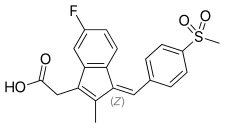Exisulind
Exisulind (tentative trade name Aptosyn) is an antineoplastic agent. It acts by inhibiting the enzyme cyclic guanosine monophosphate phosphodiesterase type 5 (EC 3.1.4.17).[1] It is the sulfone derivative of sulindac, an NSAID. Unlike sulindac, it has known effects on prostaglandin synthesis.[2] It was developed as the potential treatment of several conditions including familial adenomatous polyposis (FAP), precancerous sporadic colonic polyps, cervical dysplasia and the prevention of tumor recurrence in prostate and breast cancer.[3] Exisulind inhibits the enzyme cGMP-PDE, overexpressed in precancerous and cancerous colorectal cells, and induces apoptosis in such cells with minimal effects on normal cells. This apoptotic effect is independent of COX-1 or COX-2 inhibition, p53, Bcl-2, or cell cycle arrest. Preclinical evidence suggests that exisulind also inhibits angiogenesis.[4]
 | |
| Names | |
|---|---|
| IUPAC name
2-[(1Z)-5-fluoro-1-[(4-methanesulfonylphenyl)methylidene]-2-methyl-1H-inden-3-yl]acetic acid | |
| Other names
Sulindac sulfone, Aptosyn, FGN-1, Prevatac | |
| Identifiers | |
CAS Number |
|
3D model (JSmol) |
|
| ChEBI | |
| ChEMBL | |
| ChemSpider | |
PubChem CID |
|
CompTox Dashboard (EPA) |
|
InChI
| |
SMILES
| |
| Properties | |
Chemical formula |
C20H17FO4S |
| Molar mass | 372.41 g/mol |
Except where otherwise noted, data are given for materials in their standard state (at 25 °C [77 °F], 100 kPa). | |
| Infobox references | |
See also
References
- [No authors listed] (2004). "Exisulind: Aptosyn, FGN 1, Prevatac, sulindac sulfone". Drugs in R&D. 5 (4): 220–6. PMID 15230629.
- van Stolk, R; Stoner, G; Hayton, WL; Chan, K; DeYoung, B; Kresty, L; Kemmenoe, BH; Elson, P; Rybicki, L; Church, J; Provencher, K; McLain, D; Hawk, E; Fryer, B; Kelloff, G; Ganapathi, R; Budd, GT (January 2000). "Phase I trial of Exisulind (Sulindac Sulfone, FGN-1) as a chemopreventive agent in patients with familial adenomatous polyposis". Clinical Cancer Research. 6 (1): 78–89. PMID 10656435.
- Griffiths, GJ (November 2000). "Exisulind Cell Pathways". Current Opinion in Investigational Drugs. 1 (3): 386–91. PMID 11249724.
- Skopińska-Rózewska, E; Piazza, GA; Sommer, E; Pamukcu, R; Barcz, E; Filewska, M; Kupis, W; Caban, R; Rudziński, P; Bogdan, J; Mlekodaj, S; Sikorska, E (1998). "Inhibition of Angiogenesis by Sulindac and its Sulfone Metabolite (FGN-1): a Potential Mechanism for Their Antineoplastic Properties". International Journal of Tissue Reactions. 20 (3): 85–9. PMID 9894180.